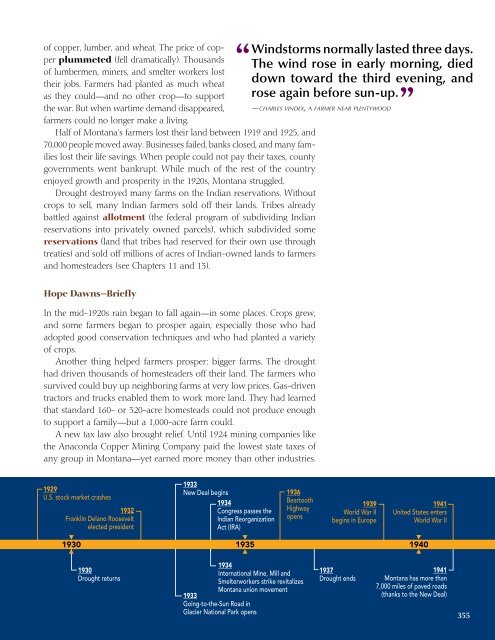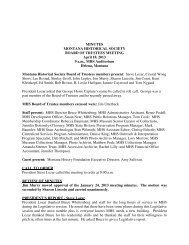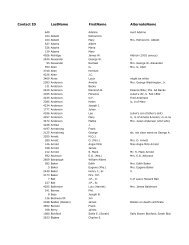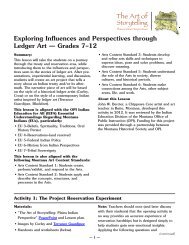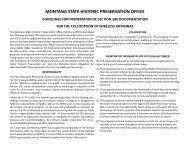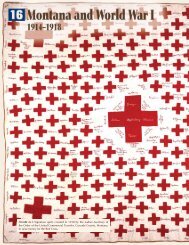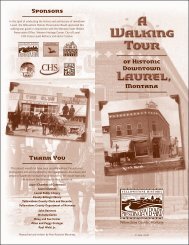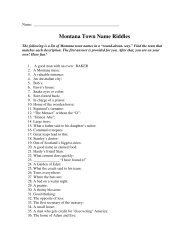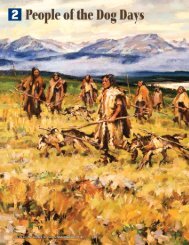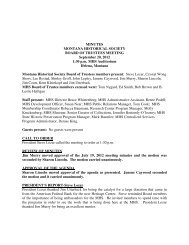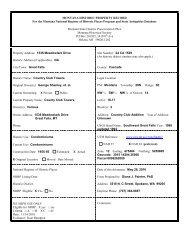No Place To Go, by Maynard Dixon, 1935 - Montana Historical Society
No Place To Go, by Maynard Dixon, 1935 - Montana Historical Society
No Place To Go, by Maynard Dixon, 1935 - Montana Historical Society
You also want an ePaper? Increase the reach of your titles
YUMPU automatically turns print PDFs into web optimized ePapers that Google loves.
of copper, lumber, and wheat. The price of copper<br />
plummeted (fell dramatically). Thousands<br />
of lumbermen, miners, and smelter workers lost<br />
their jobs. Farmers had planted as much wheat<br />
as they could—and no other crop—to support<br />
the war. But when wartime demand disappeared,<br />
farmers could no longer make a living.<br />
Half of <strong>Montana</strong>’s farmers lost their land between 1919 and 1925, and<br />
70,000 people moved away. Businesses failed, banks closed, and many families<br />
lost their life savings. When people could not pay their taxes, county<br />
governments went bankrupt. While much of the rest of the country<br />
enjoyed growth and prosperity in the 1920s, <strong>Montana</strong> struggled.<br />
Drought destroyed many farms on the Indian reservations. Without<br />
crops to sell, many Indian farmers sold off their lands. Tribes already<br />
battled against allotment (the federal program of subdividing Indian<br />
reservations into privately owned parcels), which subdivided some<br />
reservations (land that tribes had reserved for their own use through<br />
treaties) and sold off millions of acres of Indian-owned lands to farmers<br />
and homesteaders (see Chapters 11 and 13).<br />
Hope Dawns—Briefl y<br />
1929<br />
U.S. stock market crashes<br />
1932<br />
Franklin Delano Roosevelt<br />
elected president<br />
1930<br />
Drought returns<br />
“<br />
In the mid-1920s rain began to fall again—in some places. Crops grew,<br />
and some farmers began to prosper again, especially those who had<br />
adopted good conservation techniques and who had planted a variety<br />
of crops.<br />
Another thing helped farmers prosper: bigger farms. The drought<br />
had driven thousands of homesteaders off their land. The farmers who<br />
survived could buy up neighboring farms at very low prices. Gas-driven<br />
tractors and trucks enabled them to work more land. They had learned<br />
that standard 160- or 320-acre homesteads could not produce enough<br />
to support a family—but a 1,000-acre farm could.<br />
A new tax law also brought relief. Until 1924 mining companies like<br />
the Anaconda Copper Mining Company paid the lowest state taxes of<br />
any group in <strong>Montana</strong>—yet earned more money than other industries.<br />
1933<br />
New Deal begins<br />
1934<br />
Congress passes the<br />
Indian Reorganization<br />
Act (IRA)<br />
1933<br />
<strong>Go</strong>ing-to-the-Sun Road in<br />
Glacier National Park opens<br />
Windstorms normally lasted three days.<br />
The wind rose in early morning, died<br />
down toward the third evening, and<br />
rose again before sun-up.<br />
”<br />
—CHARLES VINDEX, A FARMER NEAR PLENTYWOOD<br />
1936<br />
Beartooth<br />
Highway<br />
opens<br />
1934<br />
International Mine, Mill and<br />
Smelterworkers strike revitalizes<br />
<strong>Montana</strong> union movement<br />
1939<br />
World War II<br />
begins in Europe<br />
1937<br />
Drought ends<br />
1941<br />
United States enters<br />
World War II<br />
1930 <strong>1935</strong> 1940<br />
1941<br />
<strong>Montana</strong> has more than<br />
7,000 miles of paved roads<br />
(thanks to the New Deal)<br />
355<br />
1 3 — H O M E S T E A D I N G T H I S D R Y L A N D 3 5 5


